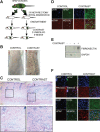Pathophysiology of gadolinium-associated systemic fibrosis
- PMID: 27147669
- PMCID: PMC4967166
- DOI: 10.1152/ajprenal.00166.2016
Pathophysiology of gadolinium-associated systemic fibrosis
Abstract
Systemic fibrosis from gadolinium-based magnetic resonance imaging contrast is a scourge for the afflicted. Although gadolinium-associated systemic fibrosis is a rare condition, the threat of litigation has vastly altered clinical practice. Most theories concerning the etiology of the fibrosis are grounded in case reports rather than experiment. This has led to the widely accepted conjecture that the relative affinity of certain contrast agents for the gadolinium ion inversely correlates with the risk of succumbing to the disease. How gadolinium-containing contrast agents trigger widespread and site-specific systemic fibrosis and how chronicity is maintained are largely unknown. This review highlights experimentally-derived information from our laboratory and others that pertain to our understanding of the pathophysiology of gadolinium-associated systemic fibrosis.
Keywords: NADPH oxidase; fibrosis; gadolinium; nephrogenic fibrosing dermopathy; skin diseases.
Copyright © 2016 the American Physiological Society.
Figures




Similar articles
-
Overlapping roles of NADPH oxidase 4 for diabetic and gadolinium-based contrast agent-induced systemic fibrosis.Am J Physiol Renal Physiol. 2021 Apr 1;320(4):F617-F627. doi: 10.1152/ajprenal.00456.2020. Epub 2021 Feb 22. Am J Physiol Renal Physiol. 2021. PMID: 33615889 Free PMC article.
-
Nephrogenic systemic fibrosis and its association with gadolinium exposure during MRI.Cleve Clin J Med. 2008 Feb;75(2):95-7, 103-4, 106 passim. doi: 10.3949/ccjm.75.2.95. Cleve Clin J Med. 2008. PMID: 18290353 Review.
-
Clinical and histological findings in nephrogenic systemic fibrosis.Eur J Radiol. 2008 May;66(2):191-9. doi: 10.1016/j.ejrad.2008.01.016. Epub 2008 Mar 5. Eur J Radiol. 2008. PMID: 18325705 Review.
-
Free gadolinium is a likely trigger of nephrogenic systemic fibrosis.AJR Am J Roentgenol. 2009 Oct;193(4):W354; author reply W355. doi: 10.2214/AJR.08.2194. AJR Am J Roentgenol. 2009. PMID: 19770307 No abstract available.
-
A timely reminder about an evolving clinical entity: nephrogenic systemic fibrosis and gadolinium use in CKD.Nephrology (Carlton). 2007 Jun;12(3):316. doi: 10.1111/j.1440-1797.2007.00799.x. Nephrology (Carlton). 2007. PMID: 17498132 No abstract available.
Cited by
-
Gadolinium distribution in kidney tissue determined and quantified by micro synchrotron X-ray fluorescence.Biometals. 2021 Apr;34(2):341-350. doi: 10.1007/s10534-020-00284-8. Epub 2021 Jan 23. Biometals. 2021. PMID: 33486677
-
Gadolinium-Based Contrast Agent Use, Their Safety, and Practice Evolution.Kidney360. 2020 Jun;1(6):561-568. doi: 10.34067/kid.0000272019. Epub 2020 Jun 25. Kidney360. 2020. PMID: 34423308 Free PMC article. Review.
-
Benefits and Detriments of Gadolinium from Medical Advances to Health and Ecological Risks.Molecules. 2020 Dec 7;25(23):5762. doi: 10.3390/molecules25235762. Molecules. 2020. PMID: 33297578 Free PMC article. Review.
-
Risk for Nephrogenic Systemic Fibrosis After Exposure to Newer Gadolinium Agents: A Systematic Review.Ann Intern Med. 2020 Jul 21;173(2):110-119. doi: 10.7326/M20-0299. Epub 2020 Jun 23. Ann Intern Med. 2020. PMID: 32568573 Free PMC article.
-
Recent Advances in Magnetic Resonance Imaging Assessment of Renal Fibrosis.Adv Chronic Kidney Dis. 2017 May;24(3):150-153. doi: 10.1053/j.ackd.2017.03.005. Adv Chronic Kidney Dis. 2017. PMID: 28501077 Free PMC article. Review.
References
-
- Abujudeh HH, Kaewlai R, Kagan A, Chibnik LB, Nazarian RM, High WA, Kay J. Nephrogenic systemic fibrosis after gadopentetate dimeglumine exposure: case series of 36 patients. Radiology 253: 81–89, 2009. - PubMed
-
- Agarwal R, Brunelli SM, Williams K, Mitchell MD, Feldman HI, Umscheid CA. Gadolinium-based contrast agents and nephrogenic systemic fibrosis: a systematic review and meta-analysis. Nephrol Dial Transplant 24: 856–863, 2009. - PubMed
-
- Anavekar NS, Chong AH, Norris R, Dowling J, Goodman D. Nephrogenic systemic fibrosis in a gadolinium-naive renal transplant recipient. Australas J Dermatol 49: 44–47, 2008. - PubMed
-
- Aoyama T, Paik YH, Watanabe S, Laleu B, Gaggini F, Fioraso-Cartier L, Molango S, Heitz F, Merlot C, Szyndralewiez C, Page P, Brenner DA. Nicotinamide adenine dinucleotide phosphate oxidase in experimental liver fibrosis: GKT137831 as a novel potential therapeutic agent. Hepatology 56: 2316–2327, 2012. - PMC - PubMed
Publication types
MeSH terms
Substances
Grants and funding
LinkOut - more resources
Full Text Sources
Other Literature Sources
Medical

